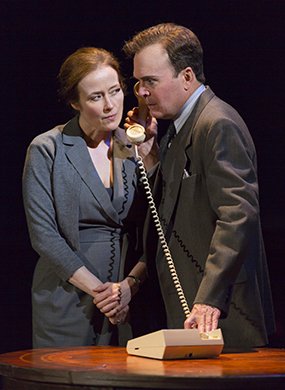
By Karen Isaacs
In September 1993, an event occurred in the White House Rose Garden that gave the world hope for a Middle East peace: it was the signing of the Oslo Peace Accords between Israel and the PLO. Israeli Prime Minister Yitzhak Rabin and Chairman Yasser Arafat were photographed shaking hands and later the two shared the Nobel Peace Prize. President Clinton looked on.
The back story that led to that historic occasion is the subject of the new play Oslo at Lincoln Center’s Vivian Beaumont Theater.
Playwright J. T. Rogers makes it very clear in his notes that this is not intended to be an absolutely accurate portrayal of the “back channel” negotiations that occurred in Oslo. He admits that locations and chronology has been changed and compressed. He has removed some characters and as he says “some of those who remain have been assigned different roles than their actual counterparts…the words they say are mine.”
But accepting that this is not a documentary, it is still a compelling though long (about three hours) drama. At times it reminded me of Lee Blessing’s A Walk in the Woods, another play about unconventional diplomatic negotiations. I saw the play first last August when it was produced at Lincoln Center’s smaller theater. The response was so enthusiastic it reopened this March in the larger Beaumont Theater. I was eager to see this play again.

For while the signing of the accords was at the White House, the US had very little to do with the entire process. That was the doing of Norwegian diplomats and Terje Rod-Larsen, director of the Fafo Institute and the husband of an official in the foreign ministry. It was his theory that for negotiations to be successful, rather than put everything on the table at once, the two parties should start with one issue and when that is resolved, go on to the next. He also believed that personal relationships are a necessity for success.
Some research assured me that Larsen, was indeed head of the Institute which focused on Labour and Social Research as well as Applied International Studies. He had a PhD in sociology.
At the end of 1992, two unofficial representatives of the Israeli government met with Ahmed Quiri, finance minister of the PLO and Hassan Asfour at a manor house outside of Oslo. Larsen insisted that the four men meet and talk alone; in the evenings he expected them to join him and his wife, Mona, over food, drink and non-business talk of families and backgrounds mixed with humor.
It was an auspicious start. The two Israelis, economists, had no authority but were reporting to the deputy foreign minister who had sent them on his own imitative. The PLO delegates had more authority and standing, but were angry and skeptical.
Over the course of months and months of meetings, the four men began not only to establish personal relationships but to hammer out an initial draft of an understanding that dealt with such issues as Jericho and the Gaza Strip.
As Mona states early in the play, it took nine months. The movement was in fits and starts. The issues were enormous. The PLO representatives wanted the Israeli negotiators to be government officials; finally that happened when Uri Savir, director-general of the foreign ministry joined the talks.
In the play, senior Norwegian officials were also in the dark about this effort for months; when the foreign minister Johan Jorgen Holst learns of the act ivies of Larsen and Mona, he is not necessarily thrilled. It is dangerous effort and could alienate the US.
Praises to director Bartlett Sher and the entire cast. Sher and his cast not only keep the pace moving and the tension building – even though you know from the outset that the agreement was reached – but they mine the humor that is necessary to keep this from being dull. His entire production team has worked in concert to fulfill his vision.
The cast returned to this play after a hiatus; their performances have deepened and sharpened. If each was good the when I saw last August, they are even better now. Director Bartlett Sher has also adjusted his staging to the larger playing space without losing either intimacy or pace.
Particular praise must be given to dialect coach Elizabeth Smith – she and the cast maintain a variety of accents – primarily Norwegian, Arab and Israeli – while remaining understandable at all times. The accents never become stereotypical but always sound authentic.
Let us heap praises on the cast. Jefferson Mays is one of my favorite actors and again as Larsen he turns in marvelous performance. Not only with the accent but the depths of the character from his certainties to his ego to his doubt. Jennifer Ehle matches his as his wife, Mona. She is steady, calming and truly diplomatic. Michael Aronov is fantastic as the Uri Savir who takes over the negotiations for the Israeli government. Dariush Kashani as Hassam and AnthonyAzizi Quiri are also outstanding. In fact, there is no one in the cast that can be faulted. Each actor whether playing one role or more, creates fully rounded characters that you know and relate to.
Oslo is a play that is well worth seeing. In fact, it is worth seeing twice.
For tickets visit Lincoln Center.